engine TOYOTA YARIS HATCHBACK 2021 Owners Manual
[x] Cancel search | Manufacturer: TOYOTA, Model Year: 2021, Model line: YARIS HATCHBACK, Model: TOYOTA YARIS HATCHBACK 2021Pages: 568, PDF Size: 110.34 MB
Page 232 of 568
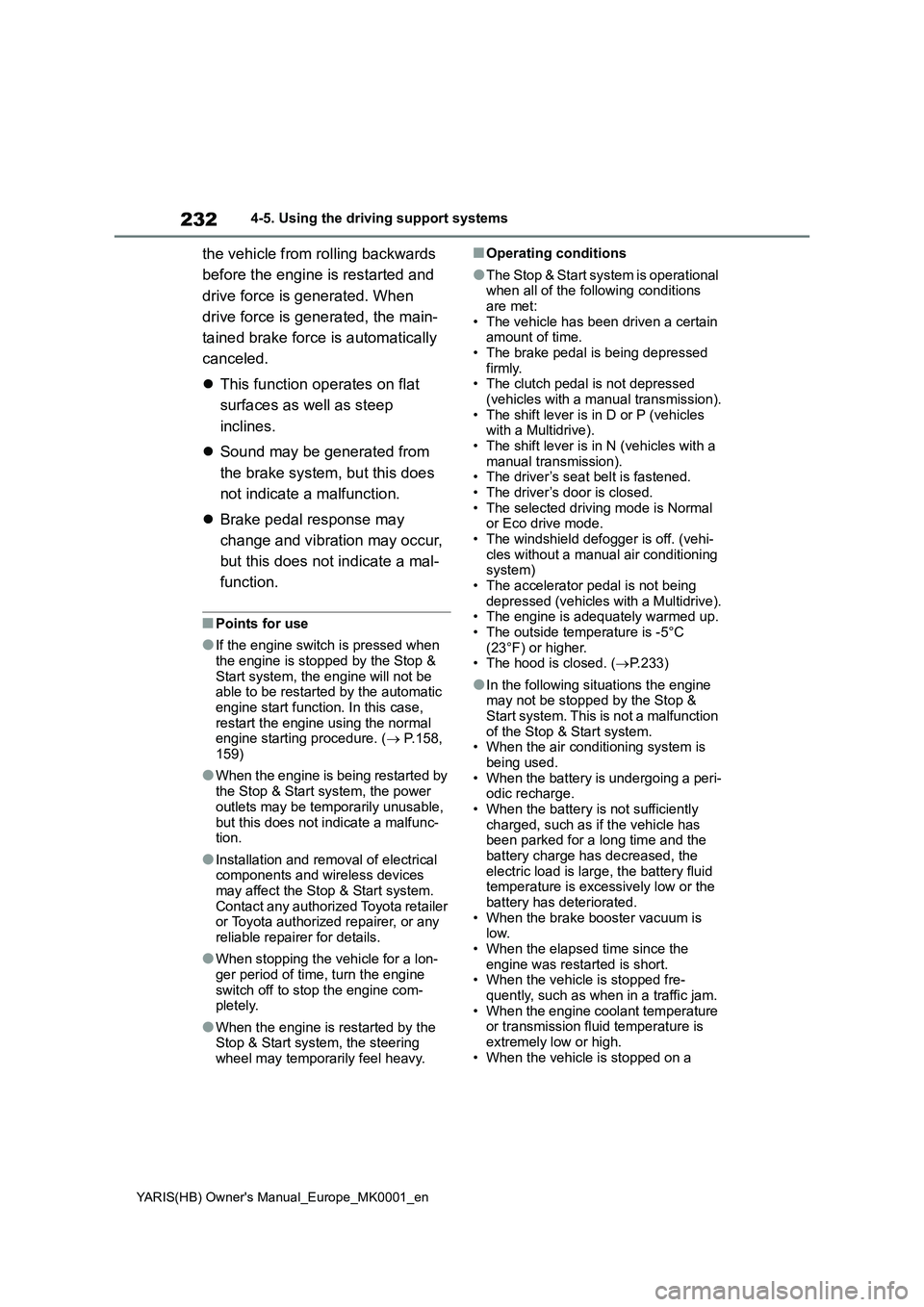
232
YARIS(HB) Owner's Manual_Europe_MK0001_en
4-5. Using the driving support systems
the vehicle from rolling backwards
before the engine is restarted and
drive force is generated. When
drive force is generated, the main-
tained brake force is automatically
canceled.
�zThis function operates on flat
surfaces as well as steep
inclines.
�zSound may be generated from
the brake system, but this does
not indicate a malfunction.
�zBrake pedal response may
change and vibration may occur,
but this does not indicate a mal-
function.
■Points for use
●If the engine switch is pressed when
the engine is stopped by the Stop &
Start system, the engine will not be
able to be restarted by the automatic
engine start function. In this case,
restart the engine using the normal
engine starting procedure. (→ P.158,
159)
●When the engine is being restarted by
the Stop & Start system, the power
outlets may be temporarily unusable,
but this does not indicate a malfunc-
tion.
●Installation and removal of electrical
components and wireless devices
may affect the Stop & Start system.
Contact any authorized Toyota retailer
or Toyota authorized repairer, or any
reliable repairer for details.
●When stopping the vehicle for a lon-
ger period of time, turn the engine
switch off to stop the engine com-
pletely.
●When the engine is restarted by the
Stop & Start system, the steering
wheel may temporarily feel heavy.
■Operating conditions
●The Stop & Start system is operational
when all of the following conditions
are met:
• The vehicle has been driven a certain
amount of time.
• The brake pedal is being depressed
firmly.
• The clutch pedal is not depressed
(vehicles with a manual transmission).
• The shift lever is in D or P (vehicles
with a Multidrive).
• The shift lever is in N (vehicles with a
manual transmission).
• The driver’s seat belt is fastened.
• The driver’s door is closed.
• The selected driving mode is Normal
or Eco drive mode.
• The windshield defogger is off. (vehi-
cles without a manual air conditioning
system)
• The accelerator pedal is not being
depressed (vehicles with a Multidrive).
• The engine is adequately warmed up.
• The outside temperature is -5°C
(23°F) or higher.
• The hood is closed. (→P.233)
●In the following situations the engine
may not be stopped by the Stop &
Start system. This is not a malfunction
of the Stop & Start system.
• When the air conditioning system is
being used.
• When the battery is undergoing a peri-
odic recharge.
• When the battery is not sufficiently
charged, such as if the vehicle has
been parked for a long time and the
battery charge has decreased, the
electric load is large, the battery fluid
temperature is excessively low or the
battery has deteriorated.
• When the brake booster vacuum is
low.
• When the elapsed time since the
engine was restarted is short.
• When the vehicle is stopped fre-
quently, such as when in a traffic jam.
• When the engine coolant temperature
or transmission fluid temperature is
extremely low or high.
• When the vehicle is stopped on a
Page 233 of 568
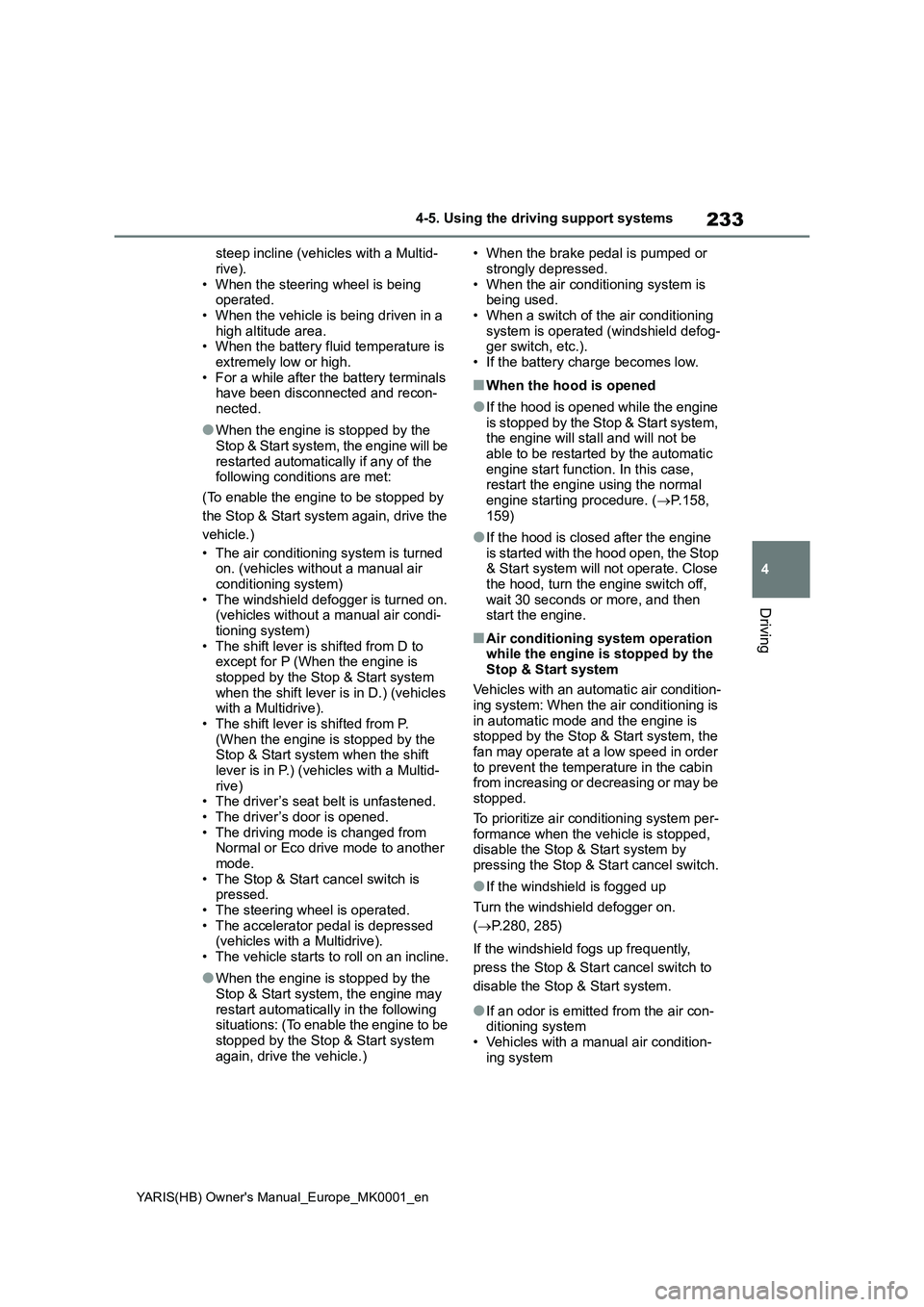
233
4
YARIS(HB) Owner's Manual_Europe_MK0001_en
4-5. Using the driving support systems
Driving
steep incline (vehicles with a Multid-
rive).
• When the steering wheel is being
operated.
• When the vehicle is being driven in a
high altitude area.
• When the battery fluid temperature is
extremely low or high.
• For a while after the battery terminals
have been disconnected and recon-
nected.
●When the engine is stopped by the
Stop & Start system, the engine will be
restarted automatically if any of the
following conditions are met:
(To enable the engine to be stopped by
the Stop & Start system again, drive the
vehicle.)
• The air conditioning system is turned
on. (vehicles without a manual air
conditioning system)
• The windshield defogger is turned on.
(vehicles without a manual air condi-
tioning system)
• The shift lever is shifted from D to
except for P (When the engine is
stopped by the Stop & Start system
when the shift lever is in D.) (vehicles
with a Multidrive).
• The shift lever is shifted from P.
(When the engine is stopped by the
Stop & Start system when the shift
lever is in P.) (vehicles with a Multid-
rive)
• The driver’s seat belt is unfastened.
• The driver’s door is opened.
• The driving mode is changed from
Normal or Eco drive mode to another
mode.
• The Stop & Start cancel switch is
pressed.
• The steering wheel is operated.
• The accelerator pedal is depressed
(vehicles with a Multidrive).
• The vehicle starts to roll on an incline.
●When the engine is stopped by the
Stop & Start system, the engine may
restart automatically in the following
situations: (To enable the engine to be
stopped by the Stop & Start system
again, drive the vehicle.)• When the brake pedal is pumped or
strongly depressed.
• When the air conditioning system is
being used.
• When a switch of the air conditioning
system is operated (windshield defog-
ger switch, etc.).
• If the battery charge becomes low.
■When the hood is opened
●If the hood is opened while the engine
is stopped by the Stop & Start system,
the engine will stall and will not be
able to be restarted by the automatic
engine start function. In this case,
restart the engine using the normal
engine starting procedure. (→P.158,
159)
●If the hood is closed after the engine
is started with the hood open, the Stop
& Start system will not operate. Close
the hood, turn the engine switch off,
wait 30 seconds or more, and then
start the engine.
■Air conditioning system operation
while the engine is stopped by the
Stop & Start system
Vehicles with an automatic air condition-
ing system: When the air conditioning is
in automatic mode and the engine is
stopped by the Stop & Start system, the
fan may operate at a low speed in order
to prevent the temperature in the cabin
from increasing or decreasing or may be
stopped.
To prioritize air conditioning system per-
formance when the vehicle is stopped,
disable the Stop & Start system by
pressing the Stop & Start cancel switch.
●If the windshield is fogged up
Turn the windshield defogger on.
(→P.280, 285)
If the windshield fogs up frequently,
press the Stop & Start cancel switch to
disable the Stop & Start system.
●If an odor is emitted from the air con-
ditioning system
• Vehicles with a manual air condition-
ing system
Page 234 of 568
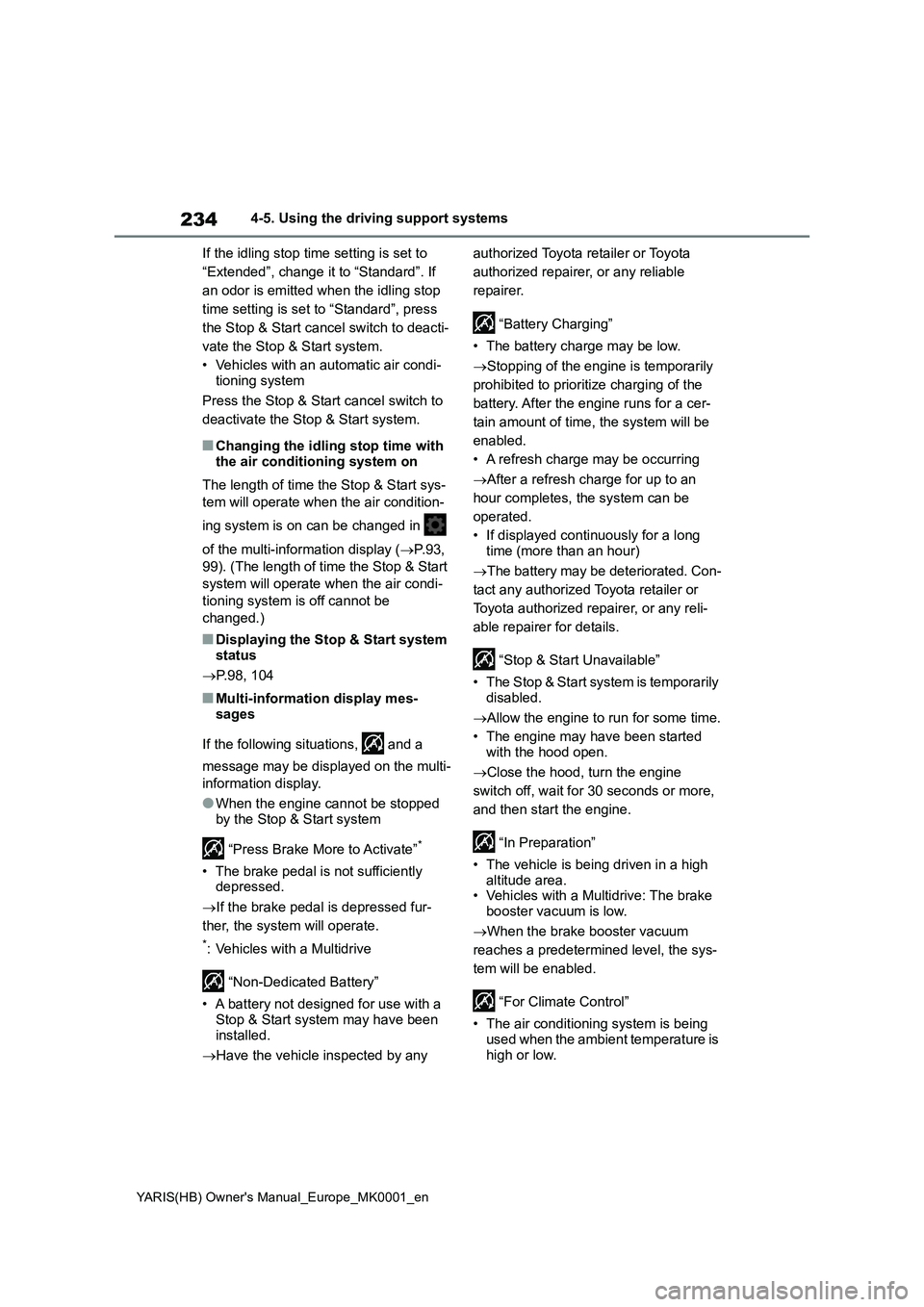
234
YARIS(HB) Owner's Manual_Europe_MK0001_en
4-5. Using the driving support systems
If the idling stop time setting is set to
“Extended”, change it to “Standard”. If
an odor is emitted when the idling stop
time setting is set to “Standard”, press
the Stop & Start cancel switch to deacti-
vate the Stop & Start system.
• Vehicles with an automatic air condi-
tioning system
Press the Stop & Start cancel switch to
deactivate the Stop & Start system.
■Changing the idling stop time with
the air conditioning system on
The length of time the Stop & Start sys-
tem will operate when the air condition-
ing system is on can be changed in
of the multi-information display (→P.93,
99). (The length of time the Stop & Start
system will operate when the air condi-
tioning system is off cannot be
changed.)
■Displaying the Stop & Start system
status
→P.98, 104
■Multi-information display mes-
sages
If the following situations, and a
message may be displayed on the multi-
information display.
●When the engine cannot be stopped
by the Stop & Start system
“Press Brake More to Activate”
*
• The brake pedal is not sufficiently
depressed.
→If the brake pedal is depressed fur-
ther, the system will operate.
*: Vehicles with a Multidrive
“Non-Dedicated Battery”
• A battery not designed for use with a
Stop & Start system may have been
installed.
→Have the vehicle inspected by any authorized Toyota retailer or Toyota
authorized repairer, or any reliable
repairer.
“Battery Charging”
• The battery charge may be low.
→Stopping of the engine is temporarily
prohibited to prioritize charging of the
battery. After the engine runs for a cer-
tain amount of time, the system will be
enabled.
• A refresh charge may be occurring
→After a refresh charge for up to an
hour completes, the system can be
operated.
• If displayed continuously for a long
time (more than an hour)
→The battery may be deteriorated. Con-
tact any authorized Toyota retailer or
Toyota authorized repairer, or any reli-
able repairer for details.
“Stop & Start Unavailable”
• The Stop & Start system is temporarily
disabled.
→Allow the engine to run for some time.
• The engine may have been started
with the hood open.
→Close the hood, turn the engine
switch off, wait for 30 seconds or more,
and then start the engine.
“In Preparation”
• The vehicle is being driven in a high
altitude area.
• Vehicles with a Multidrive: The brake
booster vacuum is low.
→When the brake booster vacuum
reaches a predetermined level, the sys-
tem will be enabled.
“For Climate Control”
• The air conditioning system is being
used when the ambient temperature is
high or low.
Page 235 of 568
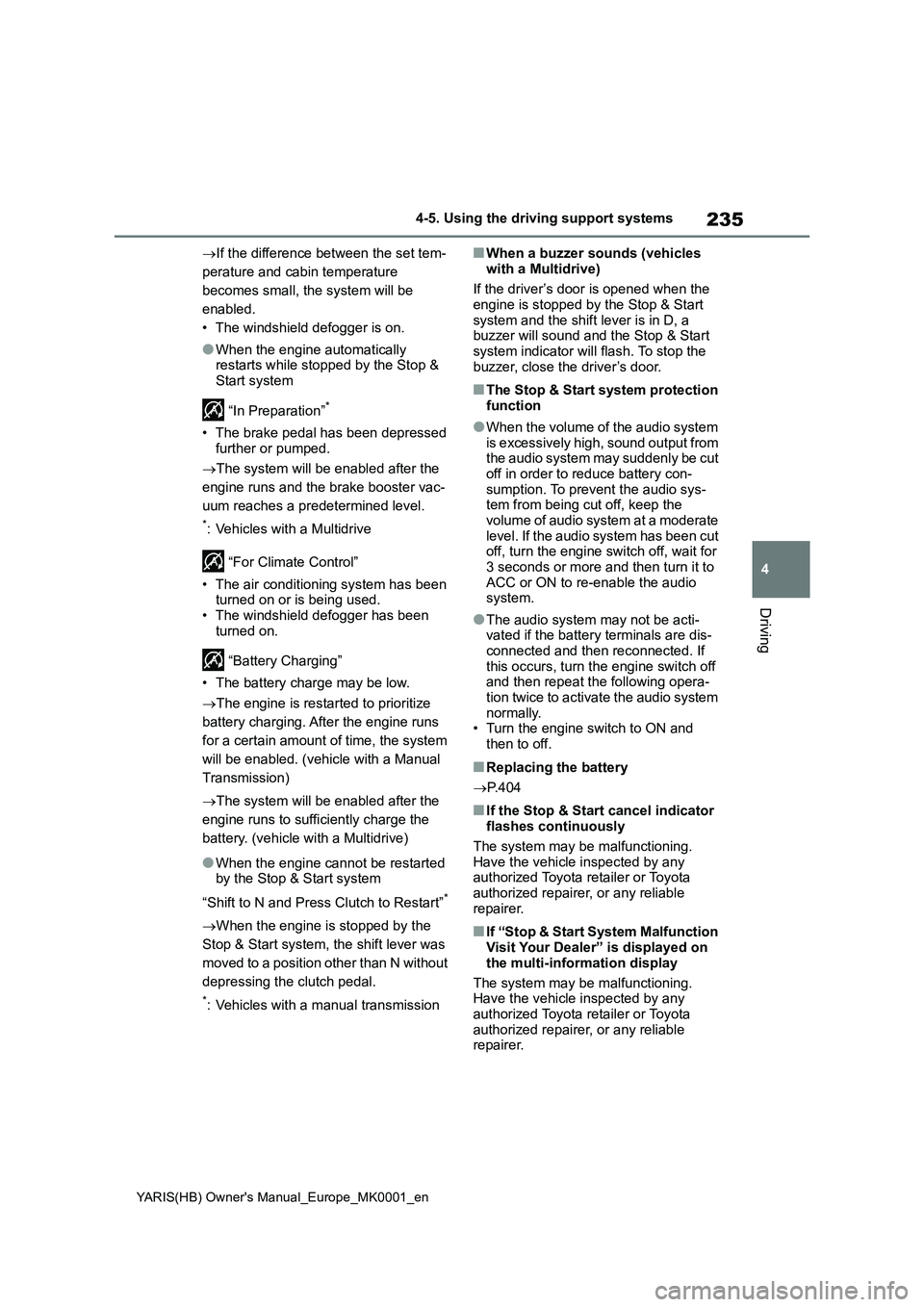
235
4
YARIS(HB) Owner's Manual_Europe_MK0001_en
4-5. Using the driving support systems
Driving
→If the difference between the set tem-
perature and cabin temperature
becomes small, the system will be
enabled.
• The windshield defogger is on.
●When the engine automatically
restarts while stopped by the Stop &
Start system
“In Preparation”
*
• The brake pedal has been depressed
further or pumped.
→The system will be enabled after the
engine runs and the brake booster vac-
uum reaches a predetermined level.
*: Vehicles with a Multidrive
“For Climate Control”
• The air conditioning system has been
turned on or is being used.
• The windshield defogger has been
turned on.
“Battery Charging”
• The battery charge may be low.
→The engine is restarted to prioritize
battery charging. After the engine runs
for a certain amount of time, the system
will be enabled. (vehicle with a Manual
Transmission)
→The system will be enabled after the
engine runs to sufficiently charge the
battery. (vehicle with a Multidrive)
●When the engine cannot be restarted
by the Stop & Start system
“Shift to N and Press Clutch to Restart”
*
→When the engine is stopped by the
Stop & Start system, the shift lever was
moved to a position other than N without
depressing the clutch pedal.
*: Vehicles with a manual transmission
■When a buzzer sounds (vehicles
with a Multidrive)
If the driver’s door is opened when the
engine is stopped by the Stop & Start
system and the shift lever is in D, a
buzzer will sound and the Stop & Start
system indicator will flash. To stop the
buzzer, close the driver’s door.
■The Stop & Start system protection
function
●When the volume of the audio system
is excessively high, sound output from
the audio system may suddenly be cut
off in order to reduce battery con-
sumption. To prevent the audio sys-
tem from being cut off, keep the
volume of audio system at a moderate
level. If the audio system has been cut
off, turn the engine switch off, wait for
3 seconds or more and then turn it to
ACC or ON to re-enable the audio
system.
●The audio system may not be acti-
vated if the battery terminals are dis-
connected and then reconnected. If
this occurs, turn the engine switch off
and then repeat the following opera-
tion twice to activate the audio system
normally.
• Turn the engine switch to ON and
then to off.
■Replacing the battery
→P. 4 0 4
■If the Stop & Start cancel indicator
flashes continuously
The system may be malfunctioning.
Have the vehicle inspected by any
authorized Toyota retailer or Toyota
authorized repairer, or any reliable
repairer.
■If “Stop & Start System Malfunction
Visit Your Dealer” is displayed on
the multi-information display
The system may be malfunctioning.
Have the vehicle inspected by any
authorized Toyota retailer or Toyota
authorized repairer, or any reliable
repairer.
Page 236 of 568
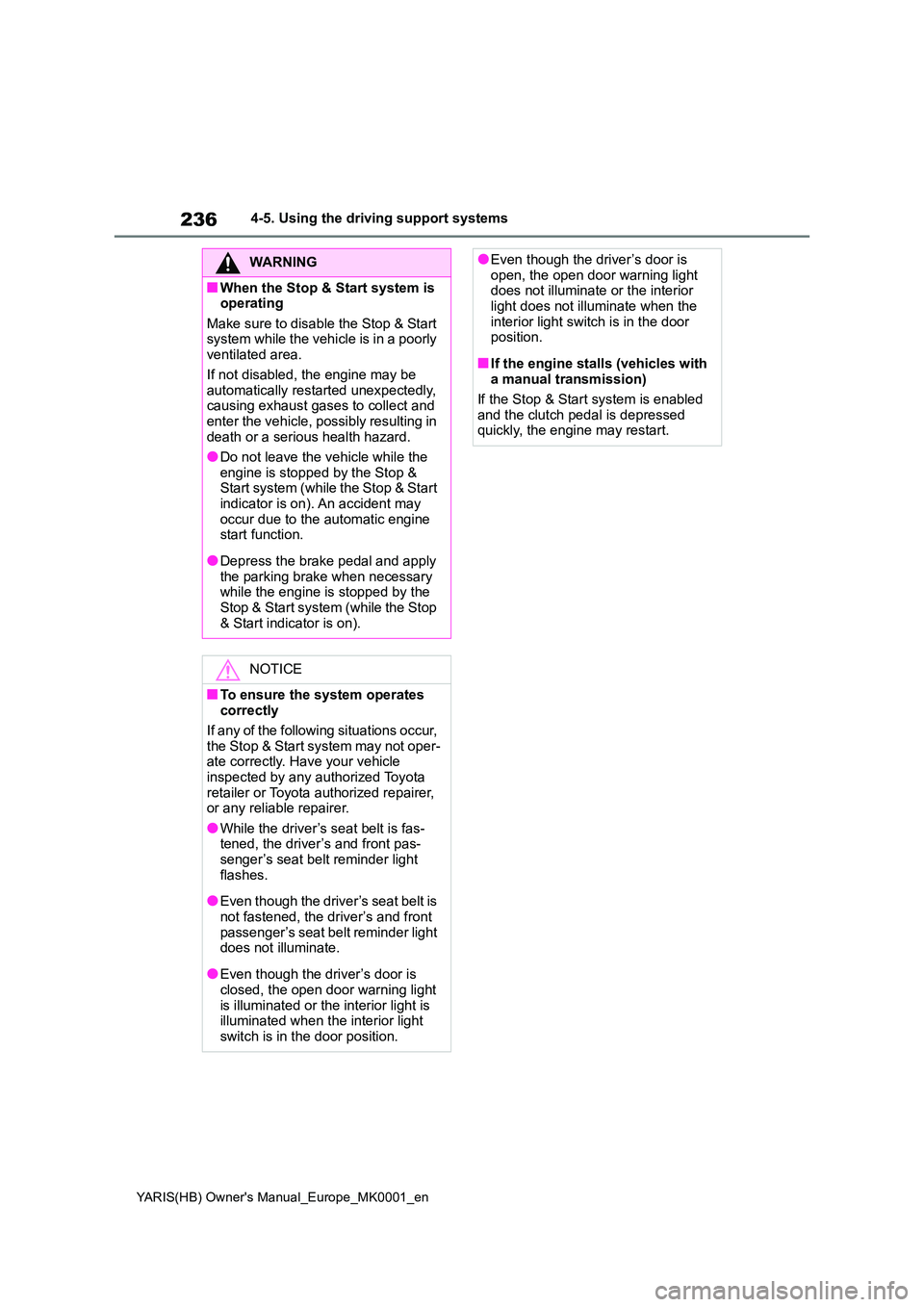
236
YARIS(HB) Owner's Manual_Europe_MK0001_en
4-5. Using the driving support systems
WARNING
■When the Stop & Start system is operating
Make sure to disable the Stop & Start system while the vehicle is in a poorly ventilated area.
If not disabled, the engine may be automatically restarted unexpectedly, causing exhaust gases to collect and
enter the vehicle, possibly resulting in death or a serious health hazard.
●Do not leave the vehicle while the
engine is stopped by the Stop & Start system (while the Stop & Start indicator is on). An accident may
occur due to the automatic engine start function.
●Depress the brake pedal and apply the parking brake when necessary while the engine is stopped by the
Stop & Start system (while the Stop & Start indicator is on).
NOTICE
■To ensure the system operates correctly
If any of the following situations occur, the Stop & Start system may not oper-ate correctly. Have your vehicle
inspected by any authorized Toyota retailer or Toyota authorized repairer, or any reliable repairer.
●While the driver’s seat belt is fas-tened, the driver’s and front pas-senger’s seat belt reminder light
flashes.
●Even though the driver’s seat belt is
not fastened, the driver’s and front passenger’s seat belt reminder light does not illuminate.
●Even though the driver’s door is closed, the open door warning light
is illuminated or the interior light is illuminated when the interior light switch is in the door position.
●Even though the driver’s door is open, the open door warning light does not illuminate or the interior
light does not illuminate when the interior light switch is in the door position.
■If the engine stalls (vehicles with a manual transmission)
If the Stop & Start system is enabled and the clutch pedal is depressed quickly, the engine may restart.
Page 243 of 568
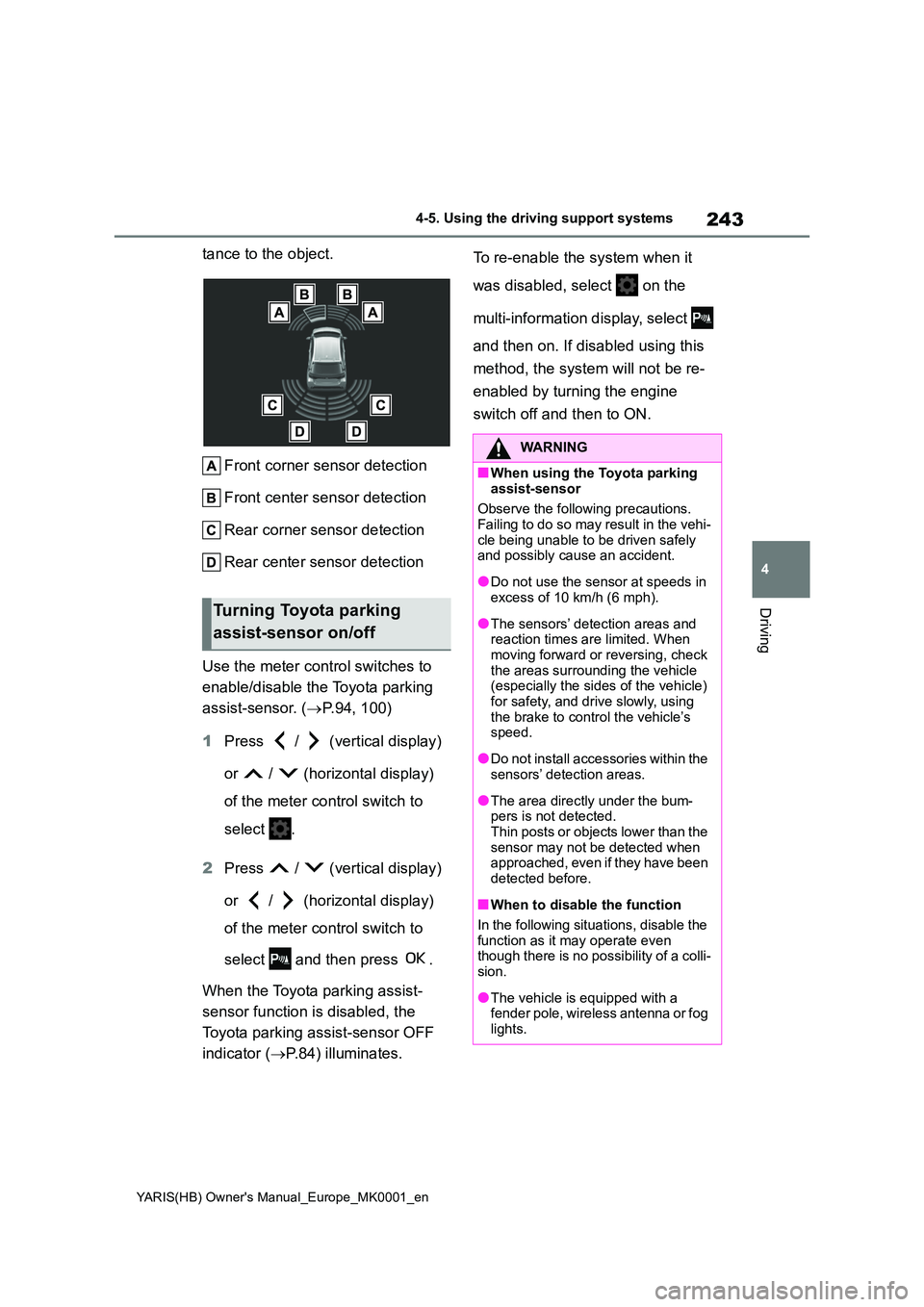
243
4
YARIS(HB) Owner's Manual_Europe_MK0001_en
4-5. Using the driving support systems
Driving
tance to the object.
Front corner sensor detection
Front center sensor detection
Rear corner sensor detection
Rear center sensor detection
Use the meter control switches to
enable/disable the Toyota parking
assist-sensor. ( →P.94, 100)
1 Press / (vertical display)
or / (horizontal display)
of the meter control switch to
select .
2 Press / (vertical display)
or / (horizontal display)
of the meter control switch to
select and then press .
When the Toyota parking assist-
sensor function is disabled, the
Toyota parking assist-sensor OFF
indicator ( →P.84) illuminates.
To re-enable the system when it
was disabled, select on the
multi-information display, select
and then on. If disabled using this
method, the system will not be re-
enabled by turning the engine
switch off and then to ON.
Turning Toyota parking
assist-sensor on/off
WARNING
■When using the Toyota parking
assist-sensor
Observe the following precautions. Failing to do so may result in the vehi-
cle being unable to be driven safely and possibly cause an accident.
●Do not use the sensor at speeds in excess of 10 km/h (6 mph).
●The sensors’ detection areas and reaction times are limited. When moving forward or reversing, check
the areas surrounding the vehicle (especially the sides of the vehicle) for safety, and drive slowly, using
the brake to control the vehicle’s speed.
●Do not install accessories within the sensors’ detection areas.
●The area directly under the bum-pers is not detected.Thin posts or objects lower than the
sensor may not be detected when approached, even if they have been detected before.
■When to disable the function
In the following situations, disable the
function as it may operate even though there is no possibility of a colli-sion.
●The vehicle is equipped with a fender pole, wireless antenna or fog
lights.
Page 244 of 568
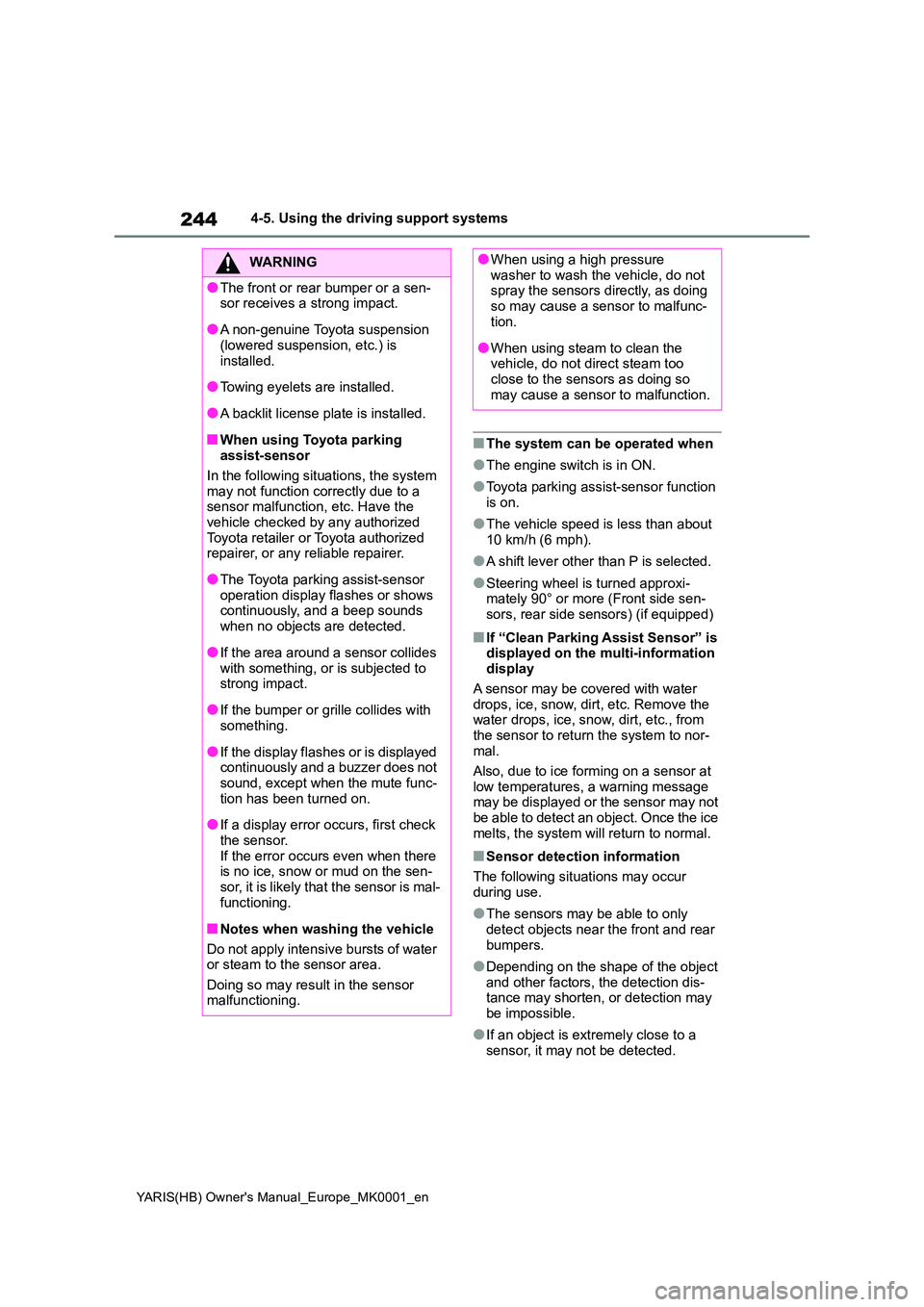
244
YARIS(HB) Owner's Manual_Europe_MK0001_en
4-5. Using the driving support systems
■The system can be operated when
●The engine switch is in ON.
●Toyota parking assist-sensor function
is on.
●The vehicle speed is less than about
10 km/h (6 mph).
●A shift lever other than P is selected.
●Steering wheel is turned approxi- mately 90° or more (Front side sen-
sors, rear side sensors) (if equipped)
■If “Clean Parking Assist Sensor” is displayed on the multi-information display
A sensor may be covered with water drops, ice, snow, dirt, etc. Remove the water drops, ice, snow, dirt, etc., from
the sensor to return the system to nor- mal.
Also, due to ice forming on a sensor at
low temperatures, a warning message may be displayed or the sensor may not
be able to detect an object. Once the ice melts, the system will return to normal.
■Sensor detection information
The following situations may occur
during use.
●The sensors may be able to only
detect objects near the front and rear bumpers.
●Depending on the shape of the object and other factors, the detection dis-tance may shorten, or detection may
be impossible.
●If an object is extremely close to a
sensor, it may not be detected.
WARNING
●The front or rear bumper or a sen- sor receives a strong impact.
●A non-genuine Toyota suspension (lowered suspension, etc.) is
installed.
●Towing eyelets are installed.
●A backlit license plate is installed.
■When using Toyota parking assist-sensor
In the following situations, the system
may not function correctly due to a sensor malfunction, etc. Have the vehicle checked by any authorized
Toyota retailer or Toyota authorized repairer, or any reliable repairer.
●The Toyota parking assist-sensor operation display flashes or shows continuously, and a beep sounds
when no objects are detected.
●If the area around a sensor collides
with something, or is subjected to strong impact.
●If the bumper or grille collides with something.
●If the display flashes or is displayed continuously and a buzzer does not sound, except when the mute func-
tion has been turned on.
●If a display error occurs, first check
the sensor. If the error occurs even when there is no ice, snow or mud on the sen-
sor, it is likely that the sensor is mal- functioning.
■Notes when washing the vehicle
Do not apply intensive bursts of water or steam to the sensor area.
Doing so may result in the sensor malfunctioning.
●When using a high pressure washer to wash the vehicle, do not spray the sensors directly, as doing
so may cause a sensor to malfunc- tion.
●When using steam to clean the vehicle, do not direct steam too close to the sensors as doing so
may cause a sensor to malfunction.
Page 245 of 568
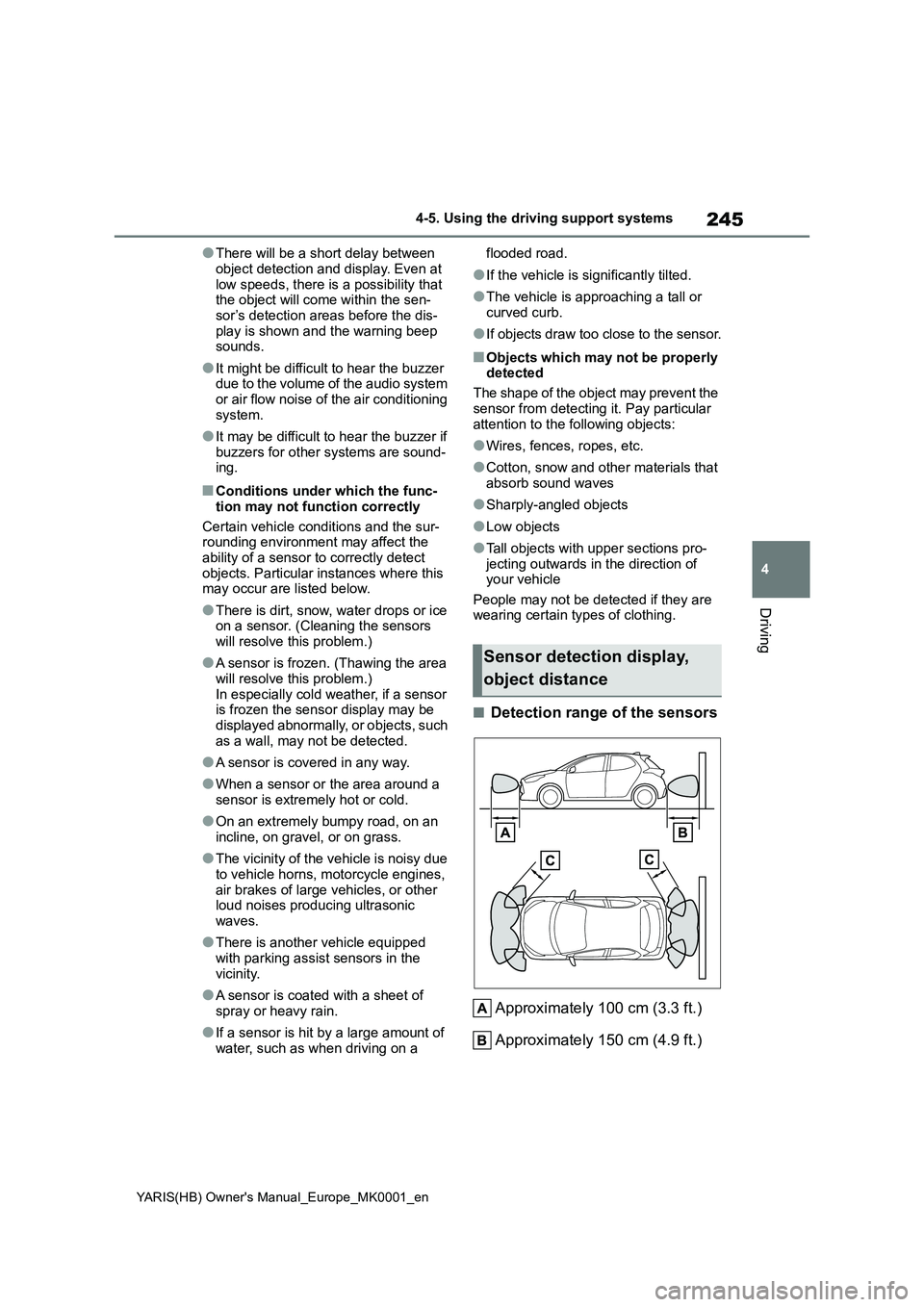
245
4
YARIS(HB) Owner's Manual_Europe_MK0001_en
4-5. Using the driving support systems
Driving
●There will be a short delay between
object detection and display. Even at low speeds, there is a possibility that the object will come within the sen-
sor’s detection areas before the dis- play is shown and the warning beep sounds.
●It might be difficult to hear the buzzer due to the volume of the audio system
or air flow noise of the air conditioning system.
●It may be difficult to hear the buzzer if buzzers for other systems are sound-ing.
■Conditions under which the func-
tion may not function correctly
Certain vehicle conditions and the sur- rounding environment may affect the
ability of a sensor to correctly detect objects. Particular instances where this may occur are listed below.
●There is dirt, snow, water drops or ice on a sensor. (Cleaning the sensors
will resolve this problem.)
●A sensor is frozen. (Thawing the area
will resolve this problem.) In especially cold weather, if a sensor is frozen the sensor display may be
displayed abnormally, or objects, such as a wall, may not be detected.
●A sensor is covered in any way.
●When a sensor or the area around a
sensor is extremely hot or cold.
●On an extremely bumpy road, on an
incline, on gravel, or on grass.
●The vicinity of the vehicle is noisy due
to vehicle horns, motorcycle engines, air brakes of large vehicles, or other loud noises producing ultrasonic
waves.
●There is another vehicle equipped
with parking assist sensors in the vicinity.
●A sensor is coated with a sheet of spray or heavy rain.
●If a sensor is hit by a large amount of water, such as when driving on a
flooded road.
●If the vehicle is significantly tilted.
●The vehicle is approaching a tall or curved curb.
●If objects draw too close to the sensor.
■Objects which may not be properly detected
The shape of the object may prevent the
sensor from detecting it. Pay particular attention to the following objects:
●Wires, fences, ropes, etc.
●Cotton, snow and other materials that
absorb sound waves
●Sharply-angled objects
●Low objects
●Tall objects with upper sections pro- jecting outwards in the direction of your vehicle
People may not be detected if they are wearing certain types of clothing.
■Detection range of the sensors
Approximately 100 cm (3.3 ft.)
Approximately 150 cm (4.9 ft.)
Sensor detection display,
object distance
Page 247 of 568
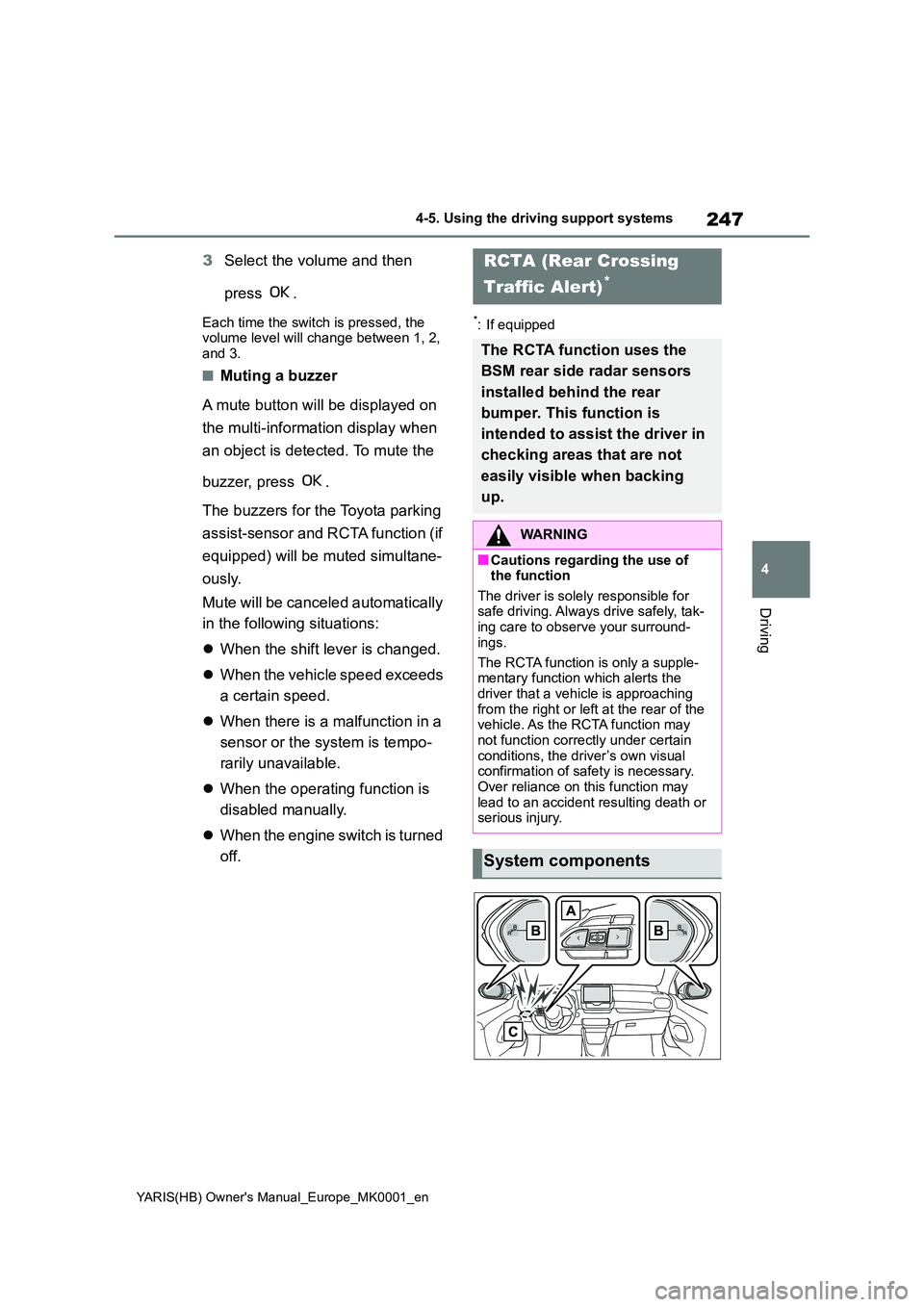
247
4
YARIS(HB) Owner's Manual_Europe_MK0001_en
4-5. Using the driving support systems
Driving
3Select the volume and then
press .
Each time the switch is pressed, the volume level will change between 1, 2,
and 3.
■Muting a buzzer
A mute button will be displayed on
the multi-information display when
an object is detected. To mute the
buzzer, press .
The buzzers for the Toyota parking
assist-sensor and RCTA function (if
equipped) will be muted simultane-
ously.
Mute will be canceled automatically
in the following situations:
�z When the shift lever is changed.
�z When the vehicle speed exceeds
a certain speed.
�z When there is a malfunction in a
sensor or the system is tempo-
rarily unavailable.
�z When the operating function is
disabled manually.
�z When the engine switch is turned
off.
*: If equipped
RCTA (Rear Crossing
Traffic Alert)*
The RCTA function uses the
BSM rear side radar sensors
installed behind the rear
bumper. This function is
intended to assist the driver in
checking areas that are not
easily visible when backing
up.
WARNING
■Cautions regarding the use of the function
The driver is solely responsible for safe driving. Always drive safely, tak-ing care to observe your surround-
ings.
The RCTA function is only a supple- mentary function which alerts the
driver that a vehicle is approaching from the right or left at the rear of the vehicle. As the RCTA function may
not function correctly under certain conditions, the driver’s own visual confirmation of safety is necessary.
Over reliance on this function may lead to an accident resulting death or serious injury.
System components
Page 248 of 568
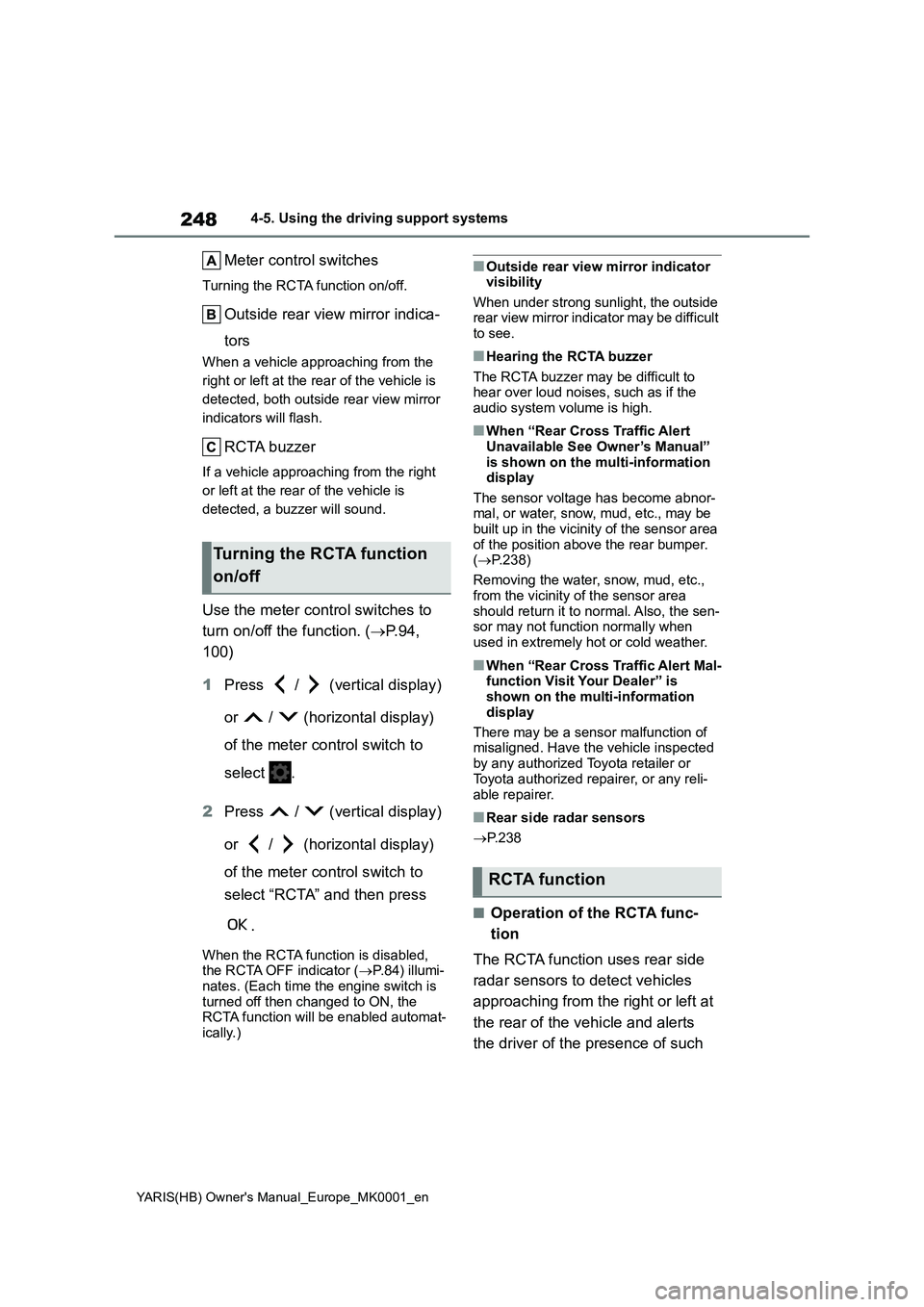
248
YARIS(HB) Owner's Manual_Europe_MK0001_en
4-5. Using the driving support systems
Meter control switches
Turning the RCTA function on/off.
Outside rear view mirror indica-
tors
When a vehicle approaching from the
right or left at the rear of the vehicle is
detected, both outside rear view mirror
indicators will flash.
RCTA buzzer
If a vehicle approaching from the right
or left at the rear of the vehicle is
detected, a buzzer will sound.
Use the meter control switches to
turn on/off the function. (→P.94,
100)
1Press / (vertical display)
or / (horizontal display)
of the meter control switch to
select .
2Press / (vertical display)
or / (horizontal display)
of the meter control switch to
select “RCTA” and then press
.
When the RCTA function is disabled,
the RCTA OFF indicator (→P.84) illumi-
nates. (Each time the engine switch is
turned off then changed to ON, the
RCTA function will be enabled automat-
ically.)
■Outside rear view mirror indicator
visibility
When under strong sunlight, the outside
rear view mirror indicator may be difficult
to see.
■Hearing the RCTA buzzer
The RCTA buzzer may be difficult to
hear over loud noises, such as if the
audio system volume is high.
■When “Rear Cross Traffic Alert
Unavailable See Owner’s Manual”
is shown on the multi-information
display
The sensor voltage has become abnor-
mal, or water, snow, mud, etc., may be
built up in the vicinity of the sensor area
of the position above the rear bumper.
(→P.238)
Removing the water, snow, mud, etc.,
from the vicinity of the sensor area
should return it to normal. Also, the sen-
sor may not function normally when
used in extremely hot or cold weather.
■When “Rear Cross Traffic Alert Mal-
function Visit Your Dealer” is
shown on the multi-information
display
There may be a sensor malfunction of
misaligned. Have the vehicle inspected
by any authorized Toyota retailer or
Toyota authorized repairer, or any reli-
able repairer.
■Rear side radar sensors
→P. 2 3 8
■Operation of the RCTA func-
tion
The RCTA function uses rear side
radar sensors to detect vehicles
approaching from the right or left at
the rear of the vehicle and alerts
the driver of the presence of such
Turning the RCTA function
on/off
RCTA function